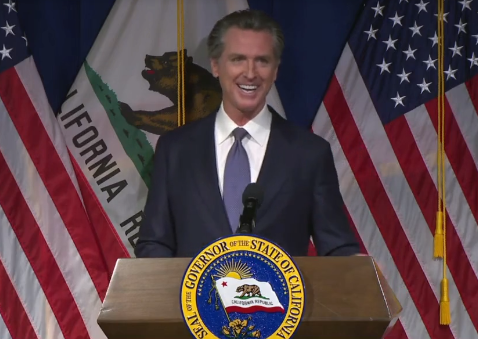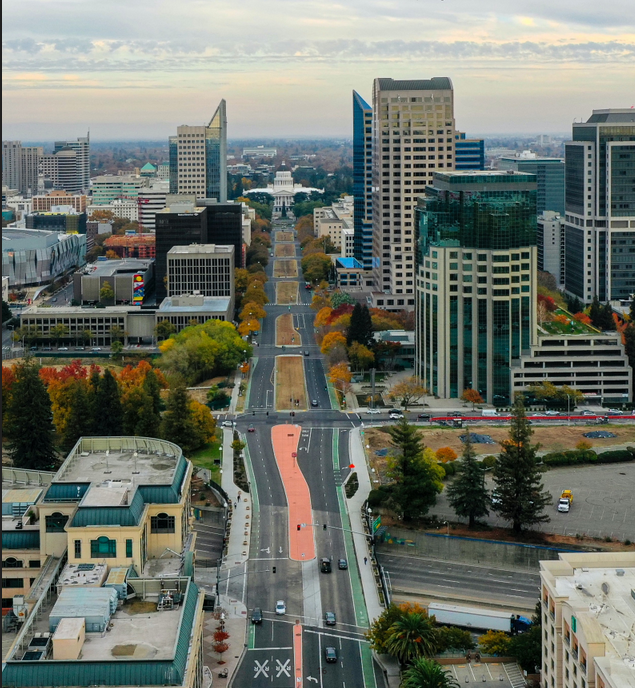Governor Gavin Newsom talked for a solid two and a half hours today about his proposed budget, the first chess move in a negotiation with the legislature that will continue until a final budget is signed in June. Other reporters will be covering the very complex details of this budget today, so let's focus on Streetsbloggy news.
Specifically on active transportation, transit, and high-speed rail.
But first let's clarify one thing: Newsom listed five "existential threats" that his budget focuses on: the pandemic, climate change, homelessness, the high cost of living in California, and safe streets. Who could blame a Streetsblog reporter for getting excited that "safe streets" maybe means a focus on Vision Zero or on fixing the speeding and distracted driving plaguing communities throughout the state has been elevated to a "top five" status.
Hear the needle scratch, because: Nope.
To Newsom, "safe streets" means "bolstering law enforcement," "prosecuting smash-and-grabs," and increasing "accountability and reform" at the Department of Justice. What a crushing disappointment. Sure, crime is a problem, but does it pose the same level of risk as the danger faced every time a California resident has to cross a street?
Sigh.
Let's start with high-speed rail, since that resulted in some shenanigans with last year's budget. That is, Newsom proposed to allocate the remaining $4.2 billion in high-speed rail bond funds that voters had approved in Prop 1 to the California High Speed Rail Authority to complete the under-construction Central Valley section, finish environmental review of the two ends in southern and northern California, and to support several transit projects on either end that will eventually connect to the finished project.
Later last year, Assembly leaders Anthony Rendon and Laura Friedman refused to allow that money to go out, throwing out a variety of dubious rationales for their resistance to see what would stick. In the process, they tanked other proposed green transportation funding, including a much-needed $500 million boost to the Active Transportation Program.
This year, Newsom has repeated the same proposal for high-speed rail. Yes, there will be negotiations again... but it's difficult to see a different outcome unless the anti-rail assembly leadership stops digging in its heels.
Newsom has also raised the amount he is proposing for the ATP to $750 million "for Active Transportation Program projects, the Highways to Boulevards Pilot, and bicycle and pedestrian safety projects." This is not the $2 billion that advocates and the CTC asked for, and it is a drop in the bucket compared to the rest of the transportation budget.
Newsom also proposed $1.2 billion over two years for "projects that improve goods movement on rail and roadways at port terminals, including railyard expansions, new bridges, and zero-emission modernization projects," and $3.3 billion "for high-priority transit and rail infrastructure ... designed to reduce traffic congestion and greenhouse gas production."
Newsom also noted that "Caltrans will continue delivering over $20 billion worth of planned state highway repair and rehabilitation projects in the State Highway Operations and Protection Program (SHOPP) over the next five years... and "over $3 billion in State Transportation and Improvement Program (STIP) projects through the plan period."
Newsom strongly emphasized that this budget would fight climate change, and restated that one of his goals is "getting the state off petroleum." He sees his $10 billion zero emission vehicle package as a way to reduce demand for oil. That money, over six years, would incentivize the development and adoption of zero emission vehicles and charging infrastructure, "doubling down" on equity requirements to make clean vehicles available to low-income people. (But truly, what vehicle has lower emissions than a bike?)
The total $9.1 billion the governor proposed for transportation infrastructure is aimed at reducing dependence on driving, according to Jared Blumenthal, who spoke to reporters about the climate package after the 2.5 hour marathon lecture by Newsom. That amount includes the proposed high-speed rail funding as well as "$3.2 billion for high priority transit projects."
The proposed transportation budget "embraces CAPTI, the transformative framework for aligning our investments with climate fight," said Blumenthal. "It will help us meet these goals as well as increase our competitiveness for federal dollars."
It's not a terrible budget. There's tons of money in California, and Newsom clearly is clearly delighting in both spending that money and reveling in the details of it. His multi-faceted focus includes cleaning up school bus fleets (with a goal of eventually electrifying all school buses), investing in education and building career pathways to a new green economy, capping unused oil wells, and retraining oil industry workers to be part of a "low-carbon economy workforce," affordable and supportive housing, and tenant protections, among many others.
One more noteworthy item: Newsom also proposes "pausing" the automatic inflation adjustment on the Road Repair and Accountability Act, which raised the gas tax in 2017 and included the automatic adjustment every year beginning in 2021 to avoid having to go back and have the same fight over the gas tax again. There's no word how that would happen; it would definitely need legislative cooperation, possibly another piece of legislation.
This item Newsom included under his "fight the high cost of living" category. He said the budget surplus would be used to fill the gap created by this failure to adjust.






